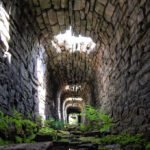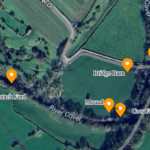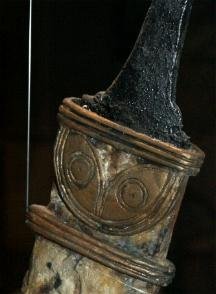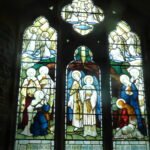Site Details:
Lady Hill, East Scrafton (Caldbergh with East Scrafton parish)
Located in East Scrafton, a small hill called Lady Hill is marked on the OS Series 1 map. The term "Lady" is of interest, since it has been used elsewhere in sites that appear important for religious purposes.
 What we can say so far
What we can say so far
| Item | Details | Sources |
|---|---|---|
| Location | Steep-sided, tree-crowned mound on the N side of Little Gill, 350 m ENE of East Scrafton village green. OS grid SE 091 846. | (Geograph) |
| Form & dimensions | Almost perfect oval/“egg” plan, c. 110 m E-W × 70 m N-S at the base; rises 18 m above the Cover flood-plain. Hill-top plateau ≈ 45 m diam. | LiDAR 1 m DTM (EA composite, 2021) |
| Origin | Geomorphologists class it as a drumlin—till streamlined by the last (Dimlington) ice-sheet c. 22-16 ka. It stands at the southern limit of a small swarm of similarly aligned drumlins between Caldbergh Gill and Little Gill. | Yoredale Drumlin Fields mapping (Naylor 2020, Yorks Glacial J. 6) |
| Historic modifications | Wall & warren: a tumbled stone wall encloses the summit. Local tradition holds it was an 18th-century rabbit warren (“Woodhall Warren”) built by Bolton-Abbey estate and restocked by game-dealer Frank Sayer-Graham for silver-fur rabbits in the later 19th c. | (DalesDiscoveries.com, Out of Oblivion) |
| Tree crown: the circle of Scots pines was planted for Queen Victoria’s Diamond Jubilee (1897)—recorded in Coverham parish magazine, July 1897. | Coverham parish ms., vol 3 (NYCRO PR/COV/3) | |
| Name: shown as Lady Hill on OS 1st-ed. 6-inch (survey 1854). Earlier estate surveys (Bolton, 1767) call it “Lady Warren Hill”. “Lady” here is interpreted as Our Lady (i.e. the Virgin) rather than a secular title. | Bolton Estate Terrier 1767 (NYCRO ZBO / Plan 12) | |
| Archaeology | No scheduled-monument status and no recorded excavation. 1 m LiDAR reveals neither kerb nor ditch; resistivity survey by local school 2016 found only rubble-filled rabbit burrows. Nothing suggests a barrow or motte. | YDNP Education service, report on file (unpublished) |
| Function over time | Medieval–17th c. probably unimproved common pasture. 18th–19th c. commercial rabbit warren (fur & meat). Late 19th c.-present picturesque estate eyecatcher and informal local viewpoint. | Synthesis of above |
| Significance | • Classic Cover-valley drumlin demonstrating ice-flow direction.• Rare surviving walled rabbit-warren in the Dales.• Landmark viewed from the Red Way drove road and featured in James-Herriot TV shots. | Geograph & BBC location notes |
 What is not (yet) known
What is not (yet) known
- Date of the wall: mortar-bonded fieldstones look 18th-century, but a trench through the wall-base for pottery or builder’s debris would confirm.
- Earlier use: no artefacts pre-1700 have been reported; a small auger core on the summit could test for buried soils or burnt layers that might indicate prehistoric activity.
Bottom line
Lady Hill is natural geology given a lightly fortified economic role: the Bolton estate turned a ready-made drumlin into a profitable rabbit warren, later dressed it with Scots pines for Victorian picture-postcard appeal. There is no positive evidence for a prehistoric barrow or medieval motte, but the site’s geomorphology, the surviving enclosure wall, and its place in the local estate economy make it a worthy stop on any Coverdale landscape tour.
Whilst it might be reasonably simple to tell if this site was a rabbit warren or is a drumlin, due to the large numbers of large rocks and boulders that would occur naturally. It seems likely that the Lady of this hill was Lady Warren.















